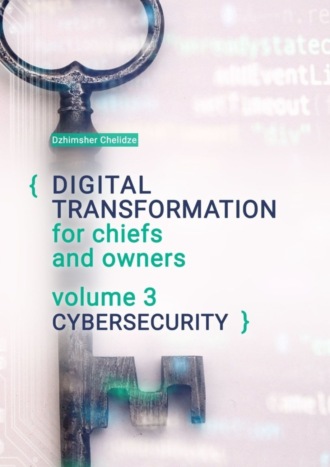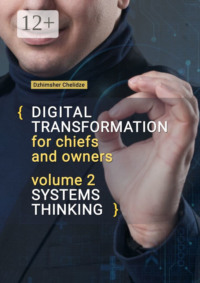
Полная версия
Digital transformation for chiefs and owners. Volume 3. Cybersecurity
Example 5
An extortion attack on a Costa Rican government facility in April 2022. A group of extortionists, Conti, attacked Costa Rican institutions and demanded a $20 million ransom. Due to the inaccessibility of most of the country’s IT infrastructure, a state of emergency was declared, and later the attacked public sector was joined by Costa Rican health care, whose institutions were attacked by the Hive group.
Example 6
Burlington City, Canada, was the target of a phishing attack in which $503,000 was transferred to a cybercriminal rather than a real service provider.
Industry and energy
The industry is increasingly attracting cybercriminals: the number of attacks in 2021 exceeds the results of 2017 by more than 7 times. Additionally, in 2022, about 10 percent of all successful attacks came from industry. At the same time, industrial companies, in fact, are not ready to withstand complex attacks and malware. Thus, 95% of companies either do not protect their automated process control systems (ACS TP) special solutions, or do so partially. Additionally, a systematic approach to cybersecurity management, such as vulnerability management and software component upgrades, is also lacking in 93 percent of cases. This is in view of the fact that the damage from stopping business processes can be catastrophic, including with damage and destruction of equipment, man-made disasters. Companies are easier to follow hackers and pay ransom quietly.
What saves us now is that it is simply unprofitable for intruders to study technological parameters, to understand exactly what to change, because you can simply encrypt or steal confidential data. In my view, that is a key deterrent.
The general trend is also maintained here – the attacks are becoming more complex:
– using Malicious Software (71% Successful Attacks)
– social engineering (about 50%)
– exploitation of software vulnerabilities (41%).
Malware itself was distributed through IT equipment (49% of cases) and mail (43%). Interruptions to technological and business processes occurred in 47 per cent of cases. Additionally, mainly because of data encryption and data deletion software (vampers). During 2022, the share of ciphers increased from 53% in the first quarter to 80% in the third. The share of waxers reached 7% (in 2021 it was 1—2%).
The increasing share of vulnerability exploitation in attacks suggests that these methods are economically feasible, which already indicates a low level of protection in industry. And it was in software and hardware products designed for industry that the most dangerous vulnerabilities were discovered and corrected in 2021.
Industrialists and power engineers like and are aware of all risks, but the specificity of the industry does not allow to conduct full-scale exercises with the development of practical scenarios and the identification of unacceptable events. Therefore, there are now emerging cyber-test sites where you can use virtual or augmented environments without the risk of breaking processes and equipment, conducting any exercises and assessing the consequences. One such example is the Standoff event organized by PT.
In general, in 2021, the interests of hackers in Russia by branches of industry were distributed as follows:
– 31% aerospace industry;
– 23% of public organizations;
– 23% of IT-company;
– 15% Military Industrial Complex;
– 8% fuel and energy complex.
As for PT statistics, in their projects from the first half of 2020 to the second half of 2021 they managed to implement 87% of unacceptable events.
Finance
The financial sector is one of those who feel relatively well. The proportion of attacks on these organizations from the total number of attacks decreases from year to year. And most interestingly, there are no new groups seeking to withdraw money from banks. The reason for this is the maturity of the industry and the efforts of the Central Bank: regulations, investments in IT infrastructure and software, established information exchange. And this is understandable, if you steal money, you can see it here and now.
Organizations are attacked again through social engineering (47%) and the use of malware (downloaders, spyware, trojans, encryptors.
Theft of confidential information and stopping of key business processes (53% and 41% of cases respectively) were typical targets of bank attacks. Embezzlement was 6% successful.
Financial institutions are now under attack with the aim of:
– obtaining a better exchange rate;
– obtaining confidential information about the user and its use in other attacks by means of social engineering;
– increase system load and failures in users’ private offices.
In addition, there are still unsafe implementations of fast payment systems.
As a result, banks introduce all new security technologies:
– tighten the checks of KYC (mandatory verification of personal data of the client), including the development of services for checking documents (video calls with document recognition, downloading photos of documents, database checks, social activity assessment) to understand whether a real person is hiding behind an account;
– introduce machine learning systems to speed up, simplify and improve customer information retrieval, identify and block suspicious transactions.
As a result, the number of standard web vulnerabilities decreases, but the number of logical vulnerabilities, on the contrary, increases. And in many ways this is due to the development of ecosystems: the creation of more and more complex integrations, microservices, the introduction of voice assistants and chat bots.
However, there are two negative factors that allow PT specialists to find vulnerabilities in each organization that allow them to penetrate the internal IT infrastructure. First, security patches released by software developers are often ignored by the IT services of organizations and are not installed. Second, there is always a possibility of a vulnerability, which is still unknown to developers, but it was discovered by researchers of intruders. Such vulnerabilities are called “zero-bottom vulnerabilities”. Additionally, these factors are the key to getting the hacker inside the infrastructure, so you need to learn how to spot them in time.
In total, PT specialists were able to penetrate the internal network of organizations in 86% of cases. PT researchers also gained full control over the infrastructure and implemented unacceptable events: access to bank-critical systems, ARMA treasurers, money exchange servers. In total, PT experts managed to implement more than 70% of unacceptable events in each financial institution.
As a result, the extortionists will continue their attacks on the banks. So far, these attacks are easier to execute and cumulatively bring more profit than attempts to withdraw a large amount of money from accounts. However, now one of the main targets of hackers will be the clients of banks that use online banking. According to the Central Bank of Russia, in 2020, 75% of adults used online banking. Therefore, hackers will continue to develop the direction of compromising banking applications. Additionally, the techniques of social engineering will remain in use.
The main method is phishing – it accounts for 60% of attacks. Hackers were happy to borrow on other people’s names, foreign companies that now need to repay these loans.
As a result, if it was previously profitable to attack companies with the aim of stealing money from accounts, the work done by the regulator, and the development of protection systems reduce the attractiveness of financial companies, need too high competence and technical equipment. However, industry is the opposite. There hackers are just interested in data about clients, internal users and any information that relates to trade secrets.
Again, this leads to an increase in attacks on confidential data (from 12% to 20%). Personal data (32%), accounting data (20%) and medical information (9%) are also popular.
In general, 14% of attacks were directed at ordinary people, and 88% of attacks were through social engineering. Additionally, the ultimate goal in 66% of the cases – accounting and personal data.
Closing the chapter, I will give some more examples of the most resonant attacks of 2022 on organizations from the commercial sector:
– Lapsus$ group has hacked a number of large IT companies. It was first attacked by Okta, which develops solutions for account and access management, including multi-factor authentication support. Nvidia’s GPU developer was then attacked, resulting in the theft of 1 TB of data, including video card driver source code and software signing certificates. The stolen Nvidia certificates were used to distribute malware. In March, criminals were able to hack Microsoft and Samsung by stealing the source code of some products.
– The Swiss airline company Swissport, which operates at 310 airports in 50 countries, has been attacked by an extortion program. The attack caused numerous flight delays and a 1.6 TB data leak.
– The attack on the telecommunications operator Vodafone in Portugal caused disruptions in service throughout the country, including in the operation of the 4G and 5G networks. Vodafone Portugal serves more than 4 million cellular subscribers.
– In October, a cyber-attack on Supeo, an IT service provider for the largest Danish railway company, stopped trains for several hours. Supeo provides a solution that machinists use to access critical information – work data on tracks and speed limits. During the attack, the provider shut down its servers, causing the application to malfunction, and the drivers were forced to stop the trains. After the restoration of train traffic, the next day did not go on schedule.
– In March, Toyota suspended 14 factories in Japan for a day due to a cyber-attack on Kojima Industries, a component supplier. The cyber-attack also affected other Japanese car manufacturers – Hino and Daihatsu Motors.
– In the second quarter, a major attack occurred on three Iranian steel mills, disrupting technological processes, and in one of the factories, the attackers managed to bring down a liquid iron bucket and cause a fire.
Chapter 5. About Technology
Cloud computing
One of the most sought-after technologies for digitalization and digital transformation are cloud computing, storage and services. Accordingly, the focus in the IS organization is increasingly shifting to the responsibility of providers. Here you need to look from two angles:
– major cloud service and infrastructure providers;
– local startups and small providers.
As for the first, everything is fine here: the major providers realize that they will attack, and therefore will take measures. Forewarned means armed. Additionally, in general, cloud services of large providers are developed on the principle of “all enemies around”, plus they have competent specialists in IS. Such centralization also allows fewer professionals to protect more data.
However, relative to startups and small providers are getting sadder. They don’t have the resources, and they’re likely to lose most of their money clients. The same applies to local data centers and IT services that develop within industrial companies. They are generally unable to provide the necessary level of protection. Or, as they said earlier, they just begin to go into a blind defense, and for business loses all sense of such cloud services, they are simply impossible to use. At the same time, the number of malware for Linux is growing.
The fact that almost 40% of all vulnerabilities identified and closed in 2021 with the help of PT researchers have a high level of danger also makes you wonder. Most importantly, 12.5% of all vulnerabilities have been identified in the software designed to provide protection against hacker attacks. Additionally, despite all the current situation and sanctions, the guys from PT comply with the responsible disclosure policy regarding the found vulnerabilities, i.e. inform the developers about all found vulnerabilities before they are published in the public domain.
Mobile applications
The second area that is developing along with digitalization is mobile applications: for customers and loyalty programs, for employees, mobile handlers, fixation of dangerous events, public services. Any larger organization has its own application.
At the same time, according to PT, the most popular vulnerability of mobile applications is storing user data in an open (or easily reversible) form. There was also a situation where important data was stored in public directories. Additionally, the overall share of deficiencies associated with unsafe data storage was more than 33% of all vulnerabilities found. That is, what hackers are interested in, and is one of the most frequent problems.
Experts of PT in 2022 conducted a study of 25 pairs of applications (Android – iOS). Almost everyone had problems with data storage. One of the key reasons is the excessive confidence of developers in system protection mechanisms at the level of the operating system, ignoring multi-level protection.
The largest share of vulnerabilities (14%) was in the public storage of user data. The second place was divided by vulnerabilities related to checking the integrity of applications and storing confidential information in the code (9%).
Additionally, almost every application has at least one of the following flaws:
– no detection of operating system hacking (root on Android and jailbreak on iOS);
– lack of integrity control of executable files;
– no obfuscation (code entanglement).
Android and iOS: who is safer?
Android apps have always been considered a good target for hackers: open system, wide options, easy to leave a hole in the app. With iOS it has always been the other way around: developers have little opportunity to make a mistake and leave the unnecessary “doors” open. Additionally, there was a paradigm – we buy for TOPs devices on iOS, and they are protected. However, now there is a change in this trend. Google is increasingly restricting applications, forcing developers to specify the necessary functionality. Additionally, according to recent news, Android 14 will completely block the ability to install legacy apps. And both through the application store and through self-downloading installation files. In iOS, by contrast, new ways of interacting with the operating system and with each other are becoming available to applications. In general, the boundary between platforms is blurred, and using iOS devices for TOPs in the hope of absolute security becomes too risky an undertaking.
Конец ознакомительного фрагмента.
Текст предоставлен ООО «Литрес».
Прочитайте эту книгу целиком, купив полную легальную версию на Литрес.
Безопасно оплатить книгу можно банковской картой Visa, MasterCard, Maestro, со счета мобильного телефона, с платежного терминала, в салоне МТС или Связной, через PayPal, WebMoney, Яндекс.Деньги, QIWI Кошелек, бонусными картами или другим удобным Вам способом.




